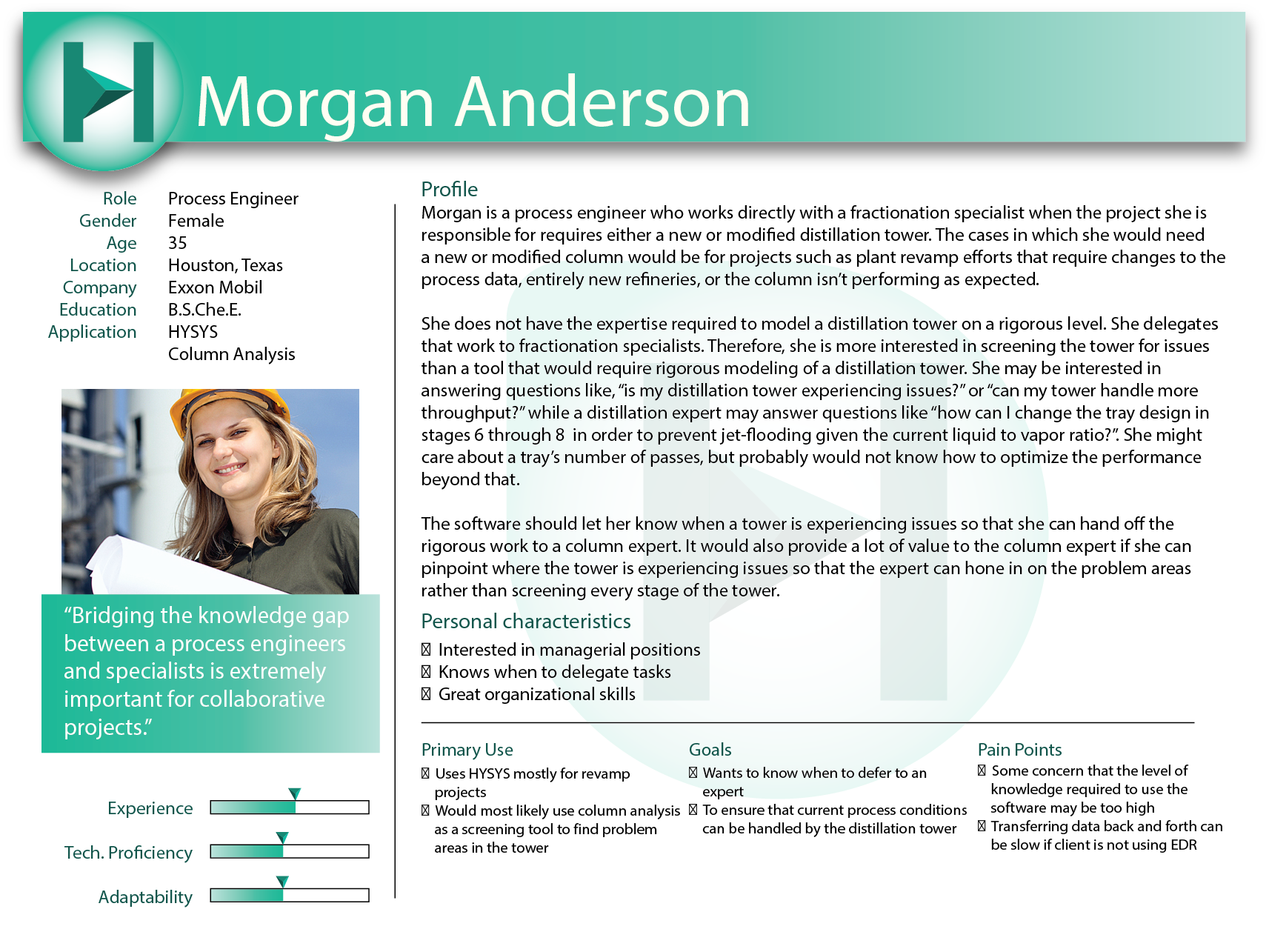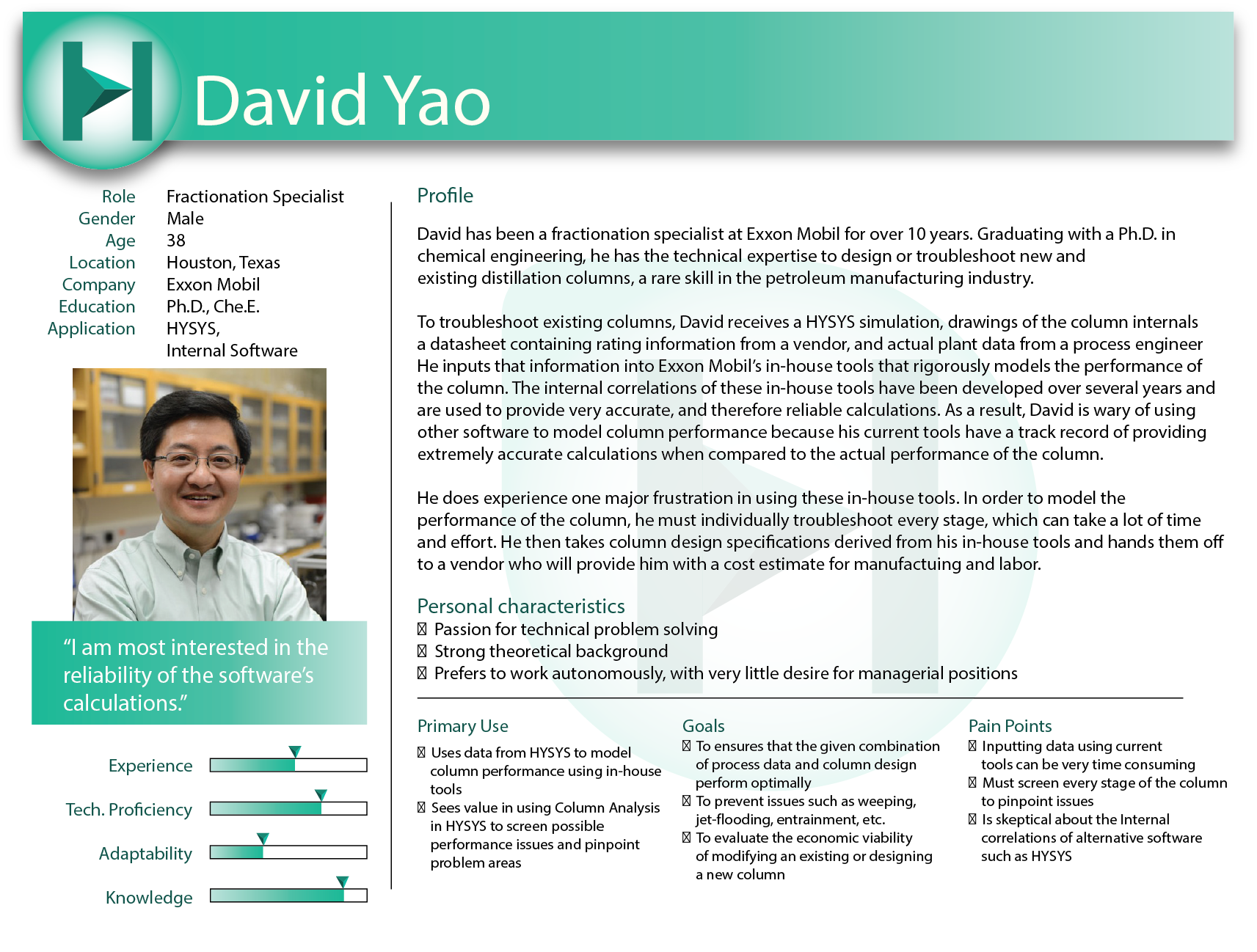
Driving Strategic Insight: Persona Development at Aspen Technology
At Aspen Technology, I initiated and led a grassroots persona research and development project, which became a foundational step in aligning our design and development processes with user needs. This initiative started during a slower period (code freeze), allowing me to explore new ways to enhance my UX skills. I discovered the value of personas, especially given how often we referred to “the user” without truly defining who that was. My question was clear: “Who is the user we keep mentioning so broadly?”
Challenges and Strategic Approach
The project’s primary challenge was gaining organizational buy-in across multiple levels. While the UX team already understood the value of personas, I needed support from upper management to secure resources and funding, as well as collaboration from product managers to integrate persona insights into their workflows. Through several presentations and discussions, I successfully communicated the strategic value of personas to the VP of Technology and a product manager, securing approval for travel expenses, interview hours, and project resources.
Research and Insights
Once resources were secured, I designed and conducted ethnographic user interviews. These sessions combined standard interview questions with product demonstrations, allowing participants to walk us through their daily workflows naturally. This approach uncovered not just what users reported doing, but how they actually interacted with our software.
The research revealed four key user groups or personas:
Three Specialist Personas: These users were highly skilled and regular users of the software.
The Generalist Persona: This group represented the majority of potential users but faced usability challenges that hindered adoption.
For generalists, I identified 2-3 key features that significantly improved usability and efficiency. Despite our software’s advanced capabilities, these users gravitated toward a competitor’s product because it saved them several hours a week—time they valued for personal goals like spending time with family. Many of these generalists were married men aged 35-45 with families, and their priority was work-life balance rather than accessing advanced software features.
Impact and Takeaways
This persona research provided actionable insights that reshaped our product strategy. By understanding the distinct needs of generalists, we identified opportunities to optimize the software for broader adoption. Additionally, the project highlighted the importance of aligning product design not only with professional goals but also with the personal priorities of users.
This initiative exemplifies how user-centered research can drive strategic decision-making, align cross-functional teams, and uncover overlooked opportunities to improve product adoption and satisfaction.
Developing User Personas for Aspen Exchanger Design and Rating (EDR) Software"
This gallery showcases a series of user personas developed to guide the design and prioritization of features for AspenTech's Exchanger Design and Rating (EDR) software. Aspen EDR is a comprehensive tool for the thermal and mechanical design, simulation, and rating of heat exchangers, enabling collaboration between process engineers, estimators, and specialists.
The personas include:
Tom Ferguson (Estimator): Focused on cost calculations and material selection while ensuring the integrity and economic feasibility of heat exchanger designs.
Morgan Anderson (Process Engineer): Integrates heat exchanger models into process simulations to optimize overall performance and efficiency.
David Yao (Fractionation Specialist): Troubleshoots and optimizes distillation columns, requiring precise thermal and hydraulic modeling of heat exchangers.
Dennis Seidel (Thermal Engineer): Designs and troubleshoots heat exchangers with a focus on reliability and performance through rigorous modeling.
Vinay Varma (Thermal Engineer): Balances complex design requirements with practical deliverables to complete projects efficiently.
Through extensive user research, including interviews and observations, I helped product management gain a deeper understanding of the environments and interactions between these user groups. This research provided high-fidelity insights into their workflows, challenges, and goals, enabling product management to prioritize features that addressed the most critical needs of each persona. By aligning development efforts with real-world user requirements, the project enhanced the usability and adoption of Aspen EDR within the industry.





Understanding Heat Exchanger Workflows: Insights from EDR and HYSYS User Research
To create these detailed personas, I conducted several individual interviews with four key users of AspenTech’s EDR and HYSYS software, representing a range of roles and industries:
A process/thermal engineer from CH2M Hill.
A process/thermal engineer from Phillips 66.
A process design engineer from Marathon.
An estimator from Beaumont Machine Works, a heat exchanger fabrication company.
These interviews provided critical insights into the deliverables, engineering processes, and workflows involved in designing, rating, manufacturing, and troubleshooting heat exchangers. The research focused on understanding the inputs, outputs, and interactions specific to each role, offering a comprehensive view of how these users engage with AspenTech’s software.
This data was instrumental in the development of detailed personas, which captured the distinct needs, challenges, and goals of these user groups. These personas became a cornerstone for aligning product development efforts with user needs and growing adoption of AspenTech’s engineering suite, including HYSYS and EDR. The insights were further visualized in a flowchart that mapped inputs, deliverables, and user workflows, ensuring clarity and actionable outcomes for product management and design teams.